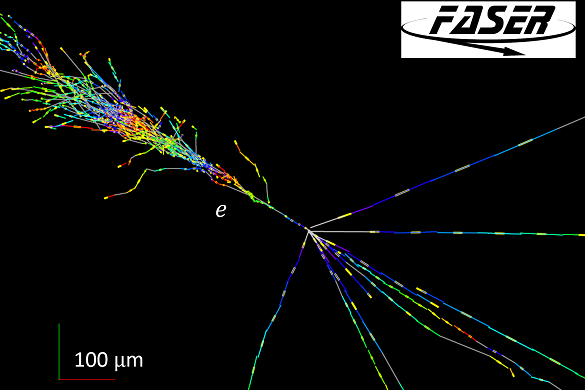Neutrino interaction rates measured at unprecedented energies
Published on

University of Liverpool researchers are part of a team that has successfully measured the interaction rates of neutrinos at unprecedented energies using the Large Hadron Collider (LHC) at CERN. A better understanding of these elusive elementary particles can help answer the question of why there is more matter than antimatter in the universe.
Neutrinos are fundamental particles that played an important role in the early phase of the universe. They are key to learn more about the fundamental laws of nature, including how particles acquire mass and why there is more matter than antimatter.
Despite being among the most abundant particles in the universe they are very difficult to detect because they pass through matter with almost no interaction. They are therefore often called “ghost particles”.
Neutrinos have been known for several decades and were very important for establishing the standard model of particle physics. Nevertheless, most neutrinos studied by physicists so far have been low-energy neutrinos generated in specially constructed facilities.
The FASER International Collaboration has successfully measured the interaction rates of electron neutrinos and muon neutrinos (two subtypes of neutrinos) with atomic nuclei at the highest energy to date (1 teraelectronvolt or TeV).
The measurement was made using the FASER detector of the FASER experiment, which measures neutrinos produced by particle collisions in the Large Hadron Collider (LHC) at CERN (European Organization for Nuclear Research in Geneva).
Notably, this is the first observation of electron neutrinos in an LHC experiment and builds upon excellent results showcased in 2023.
Dr Carl Gwilliam from the University of Liverpool’s Department of Physics was involved in the analysis of the FASER data as Physics Coordinator of the experiment.
He said: “I certainly echo the enthusiasm of FASER colleagues from the University of Bern and from Japanese institutes that have been directly involved in this, in underlining the great importance of this research. Neutrinos at such high energies offer the possibility of gaining deeper insights into the fundamental laws of nature, studying rare processes and possibly discovering new physical phenomena."
The FASERnu neutrino detector observes high-energy neutrinos produced by proton-proton collisions in the LHC. As part of FASER, it is placed underground, 480 meters from the collision point and consists of alternating layers of tungsten plates (with a density comparable to gold) and emulsion films capable of detecting particle tracks with nanometer precision. This 1.1-tonne detector with state-of-the-art technology has been in operation since 2022.
Dr Carl Gwilliam added: "In this study, a portion of the data obtained by the FASER detector in 2022 was analyzed, amounting to only 2% of the total data collected so far.”
Over the next few years the FASER experiment is et to increase, the number of neutrinos detected by a hundredfold, addressing questions about the differences between the three neutrino subtypes and possible unknown forces. The tau neutrino, the third subtype, is difficult to produce and detect at low energies.
Professor Monica D’Onofrio, Team Leader of the FASER experiment at Liverpool and national coordinator of the 4 UK FASER Institutes, said: "The high energy of the neutrinos that can be detected by FASER experiment makes it possible to generate and study tau neutrinos, the most elusive of the neutrinos and of which little is known, “. “They could provide new physical insights, so that future upgrades of the experiment will be crucially important to allow collecting larger amounts of data and perhaps find new, undiscovered physics thanks to them. "
The FASER experiment will continue to collect data until the end of Run 3 of the LHC, currently foreseen for 2025, while new upgrades are under study for the high-luminosity run of the LHC, HL-LHC, expected to start in 2029 and last for a decade.
The paper `First Direct Detection of Electron Neutrinos at a Particle Collider' (DOI: 10.1103/PhysRevLett.133.021802) is pubished in the journal Physical Review Letters.
Imagecaption: An event display showing an electron neutrino interaction event captured by the FASERν detector as viewed from the direction of the neutrino travel. The shower from the resulting electron is clearly visible in the upper left of the display.